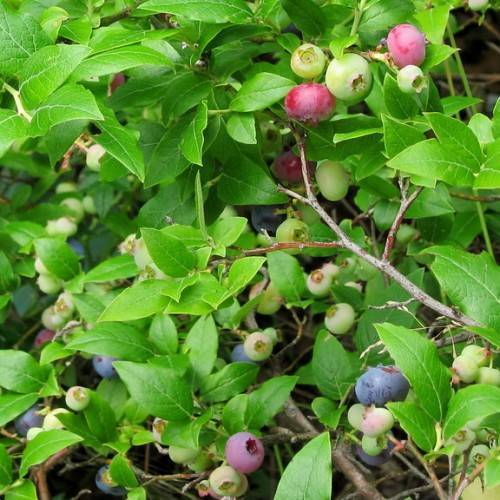
highbush blueberry
Vaccinium 'Northcountry'
Cycle:
Perennial
Watering:
Frequent
Hardiness Zone:
3 - 7
Flowers:
Flowers In Spring
Sun:
Full sun,part shade
Fruits:
Fruits Ready In
Edible:
Yes
Leaf:
Yes
Growth Rate:
High
Maintenance:
Moderate
Care Level:
Medium
watering
Water your highbush blueberry (Vaccinium 'Northcountry') immediately after planting at a rate of 1 to 2 inches per week, or enough to keep the soil lightly moist but not saturated. Make sure the soil drains well and that there is adequate air circulation around the roots. Once established, water your highbush blueberry once a week in the early morning, or whenever the soil surface begins to dry. When possible, avoid overhead sprinkling as this can encourage disease. In the winter, water your highbush blueberry either when the soil is thawed or when you expect temperatures to remain above freezing to prevent root damage from frozen soil.
sunlight
Highbush blueberry (Vaccinium ‘Northcountry’) requires full to partial sun for optimum growth and fruiting. The ideal amount is approximately 6-8 hours of direct sunlight per day. When grown in full sun, you should expect heavier fruit set and increased plant vigor. However, it is important to note that also requires some afternoon shade if in hot climates, as this can prevent heat stress. Furthermore, if planted in full sun, be sure to water in the morning so that the soil is moist throughout the day.
pruning
Highbush blueberries (Vaccinium 'Northcountry') benefit from annual pruning in late winter to maintain an open and productive habit. Pruning is done in 4 stages: thinning, heading, rejuvenating, and structural. Thinning involves removing weak or damaged canes, reducing shading and improving airflow throughout the plant. Heading involves cutting back canes to a strong bud or to a 1-year old wood with 3 buds. Rejuvenating removes older canes which have finished their production and encourages new canes to form. Lastly, structuring reduces shading and maintains an attractive shape while providing adequate support for heavy crops. For highbush blueberries, aim for approximately 8 canes of 2-3 years old with maximum height of 8-10 feet. Prune tall canes and shoots at the tips to promote lateral growth. For best results, prune highbush blueberries in late winter before buds begin to swell. Typically, early February to mid-March is the optimal time for pruning in most areas of the United States. Post-pruning fertilization with an organic fertilizer will help promote vigorous growth and better yields.
